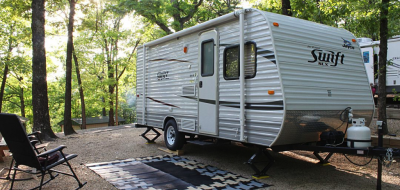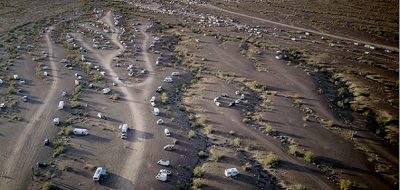By Bob Difley
Containment of gray water from the shower and sink is the weak link in the chain of methods we boondockers use to lengthen our stay between trips to replenish resources or discharge waste. These trips, where we have to pack up, put all the stuff that has accumulated on counter tops and outside, back in their storage places and drive–often several miles–to a dump or water filling station, are a disagreeable disruption to our camping trip, often taking half a day or more to accomplish.
RV manufacturers, it seems, still install gray and black water tanks that are the same size, though the gray fills up much faster than the black. My guess is that they figure that most RVers plug in to campground hookups where the size of the tank is irrelevant. But for boondockers, the gray tank is usually vastly undersized. There is a way to overcome this dilemma without breaking the law (mostly, anyway) or acting irresponsibly toward the environment.
Use the following ideas with common sense. They will work while boondocking out on public lands, but are more limited in established Forest Service or BLM campgrounds, and not a good idea in private campgrounds. The main objective is to keep your waste gray water from getting into the holding tank in the first place. Location, situation, and other factors determine whether the idea is practical and responsible:
- Collect your dishwater, rinse water, and used spaghetti water in a plastic tub and carry out to a thirsty plant or tree.
- It is important that you wipe food bits off dinnerware, pots, and pans before washing so the bits do not get in your dish or rinse water and ultimately under a bush or tree where they will attract unwanted pests and wildlife.
- Always choose a different plant to dump the water on.
- Dump well away from your campsite–twenty yards or more.
- Buy a fitting for your dump cap that has a connection for a garden hose. Attach the hose and run out well away from your campsite for draining your gray tank.
- Place hose in a clump of bushes, at base of a tree, or dig a hole for the gray water to drain into. Fill hole when you leave.
- Buy a “Blue Boy” waste water container to dump your tank into, which you can then haul to the dump station.
- Collect your shower water that you run while waiting for it to warm up and use to flush toilet, cook pasta, or use as rinse water for dishes.
- If you are effective, the filling of the black water tank will be the deciding factor of when you leave. NEVER dump your black tank OR carry some off to dump away from your campsite.
- If you are still apprehensive about dumping your gray water, consult a ranger and explain exactly what you intend to do, how long you are staying, and follow his advice.
- LEAVE NO TRACE when you leave, no evidence that you have camped there, so the site is pristine for the next boondocker.
My new ebook is finished just in time for the annual snowbird migration to the desert. Check it out: Snowbird Guide to Boondocking in the Southwestern Deserts. You can also find additional boondocking tips on my Healthy RV Lifestyle website:






Ursula
John, I see you are having the same problem with the pop-up coming up every time you try to read the blog, and asking you to subscribe, but when you try to get rid of the pop-up by subscribing all over again, it tells you that you are already subscribed. I have called Good Sam Club and told them about it, plus I have sent numerous emails to the webmaster telling them about the problem and asking them to please fix it …. but they have never fixed it. Once in a great while I seem to click on something in the blog in just the “right” way, and then I am able to read it without having to deal with the pop-up, but that does not happen very often. If they would just put an “X” on the top of the blog so that we could click on the “X” to get rid of the blog, that would help, but they will not do that. Maybe if more people would complain, they would finally fix this problem. Please call Good Sam Club and complain to them, because if they get more complaints they might finally fix it.
John
I tthought i would read the blog today but all i can see is this big banner telling me to subscribe. when i fill out the form it says i have already subscribed but the banner comes back every time i click on the site. thisis ridiculous. I am aware that I am using a different computer but if i can get the email i should be able to read the article unless it contains some information that may be dangerous to me, my family or my country. thank you for listening.
Alexandre Tarcitano
My RV is an 85 model and don´t have gray water tank. Only recent models are equipped with gray water tanks. Thouhg there is no regulation about RV´s in Brazil, every RV park has connections for gray water while camping. Black water tank is another issue. We don´t have dump stations like in US or Europe. I normally go to gas stations where interstate buses stop and ask where they dump their tanks. At least most of us proceed this way but some jerks still insist on dumping their tanks while driving and I´m sorry for those who are driving behind these guys. I´d like to catch one of them and rip their skin out and display in my living room as a trophy.
Myron Wizniak
We had purchase a new 26 ft. trailer and it came with 2 separate gray tanks and from the kitchen they call it galley tank along with the usually black.
When dumping you a extra tank that must separate drained.
Bathroom has the gray tank and black tank
I show some manufacture are looking on how to improve the gray water problem
Joy
Rich D., We will be investing in that next. Had we only known before we were spending a week in south GA and discovered gray water backed up in the bathtub! BTW, we don’t use the toilet (black tank) at all, we have a porta-potty so we don’t have to deal with odor/chemicals. It would be great for us to use the black tank as gray water holding as well.
Rich D.
A simple fresh water or wash down pump can be used in conjunction with a couple of valves to transfer gray water either to your black tank or into a container in or on your vehicle. It can then be easily transported to a dumping facility and gravity emptied using a sewer connection
Joy
In Alabama, the state parks provide literature stating that it is illegal to dump ANY water on the ground. This is for RV’s and tents. I am not saying that it is enforced, but it is posted. I never saw the point of buying a shower enclosure and hot water on demand set up for a tent if you had to figure out how to collect the water once it hits the ground!? We have a 20 ft. camper and two small children. One sink full of dishes, one tub bath and one shower later our gray tank is full. That leaves one of us dirty, which I guess could be the person in charge of figuring out how to make room for more gray water space:/ We have consequently been limited to sewer sites……..
Alden
Great article Bob! As a camper/outdoors enthusiast, I have seen the damage that gray-water can have on the environment.
I think its good to keep in mind the two dangers of gray-water: Food particles, and soap. Food can have a negative impact on the eco-system (get animals/bugs used to finding free food in an area, and possibly messes up diets) and soap can do a lot of damage, especially when it gets in near-by water.
One thing I might encourage, is if someone is planning on dumping gray-water (which I really encourage against) then use absolutely minimal amounts of soap when doing dishes/showers. 1 table spoon of bio-degradable soap, if it gets in water, has enough power to kill all the fish eggs in a pond the size of your average above-ground swimming pool.
@Judith-
I think the principle difference is simply a quantity thing… a tent camper will be making substantially less gray-water than an RVer (On average, there are exceptions). Although, I think most places encourage environmentally friendly practices for them as well, filter out food particles, and use little, if any, soap.
Judith Hanks
One thing that has confused me – a park host told us that we couldn’t let gray water out on the ground, but it’s okay for the tent campers to throw their dish water out on the ground. What’s the difference?
Barry & Monique Zander
Two related suggestions. We bought strainers made for each sink. They minimize solids getting into the grey-water tank. I also use grey water to put out the campfire at night.
Marshall
One possibility is to replace your toilet with a composting type toilet (ie natureshead.net or airheadtoilet.com). Then you could use the black and gray water tanks for gray water. We have a camper and a sailboat. If you think you have problems with waste water in a camper, you should try managing it on a boat. Another idea: I am considering making additional tanks out of pvc pipes that can be placed in confined spaces on my sailboat. They can hold pretty good volume. I was surprized by the number of gallons. Still working out the flow and emptying part of this idea. You have probably seen pvc piping used to house sewer hoses on campers. Why not attach a number of these under the camper in series to your system to enhance the capacity? Of course you will need inlet, outlet and maybe a vent.
Carol & Wayne
thanks for your advice – Our 5th wheel has a telescopic draining system for the grey and black, do you know of a way that we can bypass this system to place a hose for the grey water?
Thanks
Geoffrey Pruett
And one other help for tank range, a “range extender” for which the soft adaptor can be purchased at most trailer supply outlets. The purchased from trailer supply is two soft (almost) seals for plastic plumbing pipe used to join both tanks at about the 80% point. The only down side is that you have to charge both tanks to avoid building odors. First time (3 rigs ago) we used this was a class C with the tanks already compromised as the black tank recieved both the throne and shower as plumbed which really skewed the fill rate. Worked so well that it has gone on each replacement rig. With both of us showering daily and the normal amount of dish washing etc we camp for up to a week with out dumping but do have to add fresh water. Check the spacing before starting this as some tanks are mounted in a cramped fashion making it hard to drill the needed holes and install the pipe as the glue dries.
KIirk Singer
Since the odor of gray water will “give you away” I have started using a gray water tank treatment.
Lynne Schlumpf
Better NOT dump gray water (or black for that matter) on the ground in Alaska, or you’re looking at some HUGE fines. Most people here rely on groundwater for drinking water (wells).
Just an FYI
Drew
You can also put an outlet knife valve at the termination- keep it closed until you dump, and then open both gray and black valves- allowing the gray water to go into the black tank, until both tanks have equal level.
Don P
My RV (’98 Monaco Diplomat) has a 65 gallon gray water tank and a 35 gallon black water. I have been in places in the desert where you are encouraged to dump your gray water on the ground. The cap on my gray water tank has a hose fitting (which you can purchase at any RV store) and so I hook up a hose, kept for that purpose, and drain the gray water a few yards from my (and anybody else’s) rig so it doesn’t make mud near the camp site.
When I get to the point of having to dump the black water tank I make sure there is at least some gray water left in the gray water tank because it makes a good flush for the sewer hose after you’ve dumped the black water.
I suppose for two people your suggestion makes some sense but for me, a single traveler, when I’ve finished cooking and eating a meal and washed, dried and put away the dishes, I wouldn’t feel much like carrying a tub of dishwater (careful not to spill) down my steep steps then walk however far to dump it on a plant. I think the hose method accomplishes the same thing but easier and with less risk of a spill inside the motorhome.
Brian Cloke
In Canada we are required to have a bucket of water available whenever we use a camp fire or other means to make sure the fire is out cold before leaving.
A garden hose hooked up to the gray dump valve can be used to fulfill this requirement. If one is camping for several days this can be used efectively to keep the gray water tank from filling up.
Cheers.
Brian.
Carl C
John, I can’t intelligently speak for an 87 RV; however, usually gray water is, usually, any water that is collected that is not human waste (#1 & #2). Shower water, kitchen sink, etc are classified as gray water.
Human waste is classified as black water.
Wear disposable rubber gloves when emptying your tanks as salmonella and other nasty little bacteria / virii tend to be present in those tanks.
Bob Difley
John asks, “We are new to RVing;therefore this is probably not a dumb question. Which tank is the gray water tank? We own a 1987 28′ Class C motor home.”
John – You’re right, there are no dumb questions. Most RVs have a single holding tank for fresh water and two holding tanks for waste water, one that your toilet drains into–the black water tank–and one that your shower and sink drain into–the gray water tank. On some older RVs, there was only one holding tank that everything drained into. To check, if you have two dump valves that you pull to dump the tanks, you have two holding tanks, and if you have only one valve, you have a single holding tank. A single tank should never be dumped other than in a designated dump station.
Mike
If you are not too far from a town there are companies with trucks that will pump down both of your tanks and refill your fresh water.
bill
ok, so you need a smaller black and bigger gray? why not get creative and use the gray to flush the toilet? If you are going through all you suggest, then the grey water should be fine for the toilet. just buy an extra 12v water pump and filter, plumb into the grey tank and then connect the ouput to the toilet input. yes, it is a hassle to do, but it makes the black tank into an overflow grey, and maximizes the fresh water usage as well. many municipalities are allowing such plumbing mods now (shower and bath and bath sink, not kitchen sink) to save treated water. usually, black + grey = fresh so, you will run out of fresh as the two other tanks fill.
John
We are new to RVing;therefore this is probably not a dumb question. Which tank is the gray water tank? We own a 1987 28′ Class C motor home.
Harris Schultz
On gray water issues, when we expected to be settled for several days, we often collect dish water and pour it in the black tank. We’ve read/heard that this is not always good to do as seals, etc. in human waste tanks don’t like some ingredients in detergents. Hard to believe the industry manufactures with different seals. Have also heard/read that the tank size issue is to favor the human waste tank with enough capacity to dump the solids, tho’ we’ve never had a problem. We aren’t boondockers but have stayed a week or more with small tanks. Have also lived in states that issued rules against dumping even the gray water that were quite stringent. So your cautionary words are wisdom for the uninitiated.